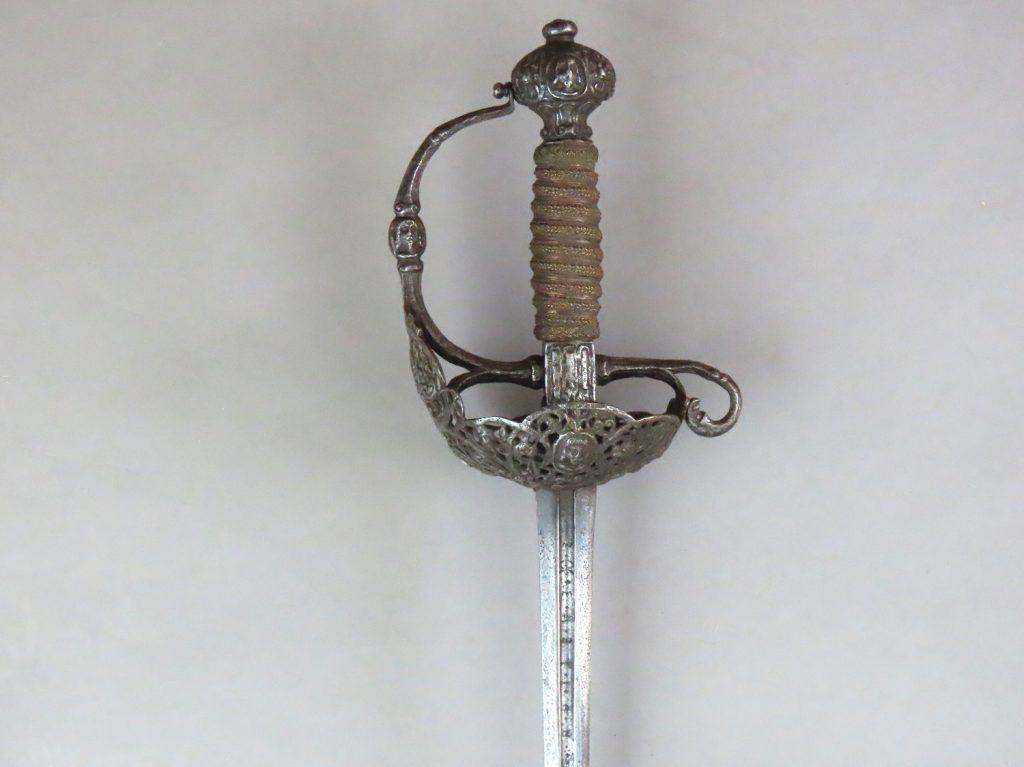
An English Rapier dating to circa 1620 to 1630
To enquire about this itemplease click here
Price: £5,600
Ref: 42501807
Item Description
A rare and interesting English Dish Hilted Rapier dating to the second quarter of the 17th century. The guard is sumptuously pierced and engraved in the highest quality English manner for the time. The hilt is very similar to that illustrated by Keith Dowen in “Arms and Armour of the English Civil Wars”, Royal Armouries Museum, 2019, page 73 and on the front cover. The rapier is in the Royal Armouries collection reference: IX.883. Both rapiers were most likely manufactured by the same man.
The hilt consists of a bold rectangular quillon block from which downward facing pointed langets are forged tight against the ricasso of the blade. A knucklebow emerges horizontally at the front and curls upwards towards the pommel front where its flattened terminal is bent to the vertical, pierced and screwed to the pommel. To the rear a horizontal quillon emerges and curls downwards in a scroll and terminates in a beast’s head finial. From beneath the knucklebow and the quillon two pas d’ane rings curl downwards with the terminals forged onto the dish guard. The dish is a symmetrical bowl with an upward facing tapering extension to the front, the end of which which is forged onto the knucklebow, about a quarter of the way up. The pommel is of slightly flattened globular form with a pronounced ribbed integral pommel button on top and a flared neck beneath with a grooved rim.
The chiselled and pierced decoration to the hilt is quintessentially English for the time period and of exceptional quality. The dish guard is formed with four primary circular panels with secondary overlapping arched panels between. The four primary panels are sculpted with the head of a wigged man inside a roundel in the centre, flanked by beast’s heads either side which face the masks, held together by intricate foliate shapes and tendrils. The secondary panels incorporate the same beast’s heads to face away from each other, and above these in each case is the head of a cherub and a floret beneath. The upward extension to the dish at the front is centred with another wigged head with counter facing beasts beneath, both features of larger form, supported by further tendrils and foliage.
The knucklebow and quillon are decorated with fluted lines and knops towards the terminals. A similar masked head forms a roundel on each side of the knucklebow at halfway. Front and back the pommel is decorated with the chiselled masked head faced by beasts on each side amongst tendrils and foliage. The pommel base is cut to resemble a classical Corinthian column with similar, but less detailed design, applied to the quillon block.
As is usual with the best English swords of this period the grip is an impressive piece craftsmanship in its own right. It has a wooden core of slight baluster profile and rounded oblong section. It is tightly spirally grooved with each groove bound with flat copper strip with thinner wires of rounded section on each side. The ridges between are mounted with two counter facing copper ropes with thinner twists on each side. Tightly woven copper “Turks Heads” are mounted top and bottom.
The stiff tapering blade is of lenticular section with a pronounced deep fuller extending for 9 inches (23 cm) from the hilt. Letters repeated on each side inside the fuller are spaced with dots and read the name of the blademaker “SEBASTIAN HERNANI” with a quatrefoil of dots punched after the end of each name and between. Shortly after the fuller terminates an orb and cross mark is incised on both sides.
The condition of the rapier is lightly pitted and patinated overall which in no way detracts from the fine quality of the workmanship. There are no repairs, breaks or noticeable damages to the hilt which retains its pleasing original shape. The blade is of fine quality though as yet we have not identified the blade maker. The blade is 35 inches (89 cm) long and overall the rapier is 42.25 inches (just over 107 cm) long overall. The length of the blade is shorter than that employed specifically for duelling and indicates that the rapier may have been put to a more general military use by a member of the English officer class.



































